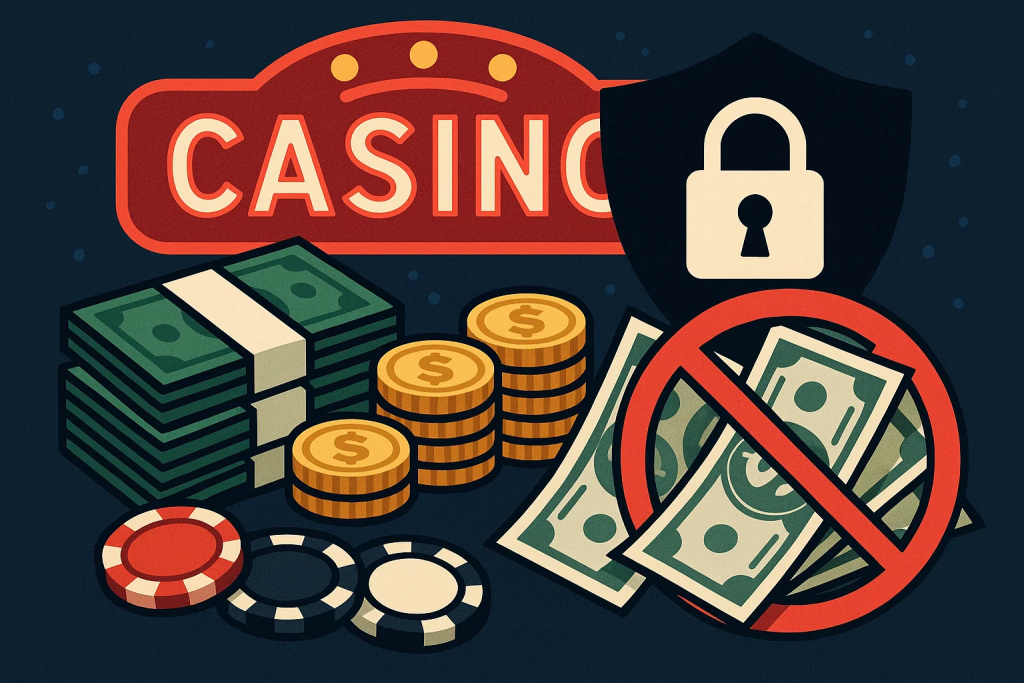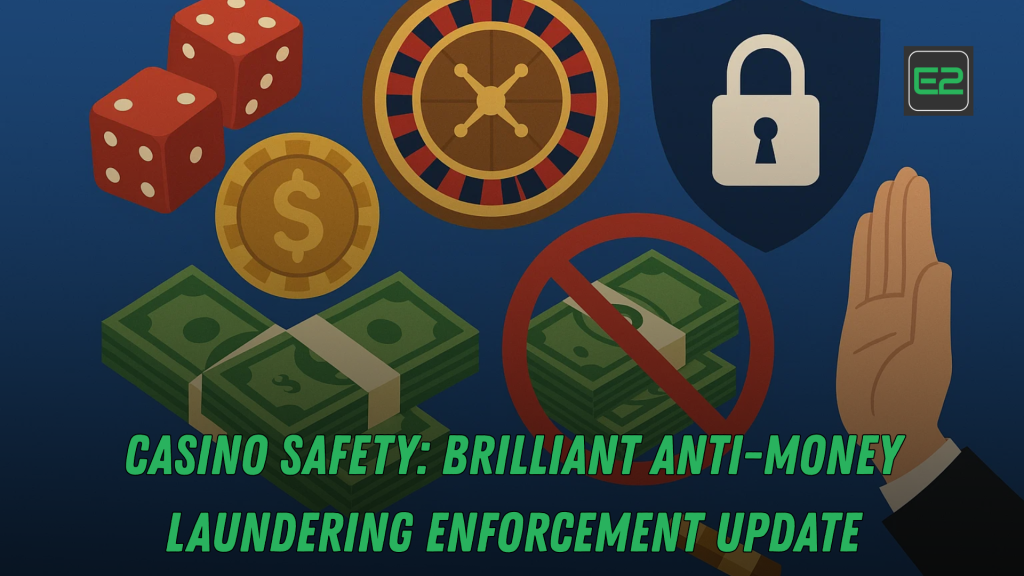Table of Contents
Casino Safety: Casinos around the world are moving from paper policies to living, measurable systems that protect players, brands, and licenses. In 2025, regulators expect programs that don’t just “exist,” but actually work under pressure: robust risk assessments, clean data flows, timely reports, trained frontline teams, and board oversight that holds everyone to account. In short, casino safety is no longer a department—it’s the operating system. This long-form enforcement update turns regulations into action. You’ll find what’s changing, how to translate rules into daily routines, and which metrics prove your casino safety program is both effective and efficient.

Executive takeaways
- Enforcement has shifted from box-ticking to outcomes. Authorities judge casino safety by whether suspicious behavior is detected, escalated, and reported on time—not by the length of your manual.
- Cashless wallets, remote onboarding, and omnichannel play raise new risks; aligning product design with casino safety controls is now a competitive advantage.
- Boards and C-suites are expected to understand risk maps, ask tough questions, and fund fixes. That governance trail is a core artifact of casino safety.
- Culture matters. Properties with short feedback loops—compliance + surveillance + cage + hosts—outperform during exams and emergencies because casino safety is built into how they work, not bolted on.
Why AML enforcement is now the front line of compliance
Historically, casino controls focused on game integrity and physical security. Today, the largest exposures often travel through financial rails: cash in, chips, wallets, wires, third-party payments, and cross-border patrons. Regulators increasingly define casino safety through a financial-crime lens because laundering, terrorist financing, fraud, and sanctions evasion can all exploit gaming venues. A modern program must prove three things:
- You understand your risks by product, channel, and customer.
- Your controls match those risks and operate reliably.
- You generate clean evidence—data, narratives, minutes—that your controls deliver casino safety outcomes in real time.
Global enforcement themes reshaping operations
1) Risk-based programs, not one-size playbooks
Regulators favor targeted controls anchored in a current enterprise risk assessment. If a venue runs high-limit rooms, hosts cross-border VIPs, or pilots cashless accounts, the risk register—and the evidence pack—must show how casino safety controls scale for those realities.
2) KYC, SoF, and SoW as stories, not checklists
Knowing your customer is more than collecting documents. For higher-risk patrons, you need a coherent story: who they are, where funds originate, and why patterns make sense. Story clarity is fast becoming a signature of mature casino safety.
3) Data quality and unification
Cage systems, table ratings, wallet platforms, loyalty databases, and fraud tools must talk to each other. Disconnected data produces blind spots; integrated views power better alerts, stronger cases, and credible casino safety dashboards.
4) Reporting discipline
Suspicious activity and large cash transactions must be filed on time with narratives that explain the “what,” “why,” and “how much.” Late or thin filings are common findings that undermine casino safety credibility.
5) Governance and culture
Boards are asked to challenge management, allocate budgets, and track remediation. Examiners increasingly request minutes and packs that demonstrate casino safety is led from the top, lived on the floor, and tested by independent functions.
Translating rules into an operating system
A resilient program blends policy, process, people, and platforms. Below is a practical architecture you can deploy and defend.
Policy foundation
- A concise, risk-based policy that names accountable owners and ties risks to controls.
- Procedures for onboarding, SoF/SoW verification, transaction monitoring, investigations, and reporting—all written for the people who use them.
- Clear escalation paths that show how frontline observations become cases and, if needed, reports—an essential spine of casino safety.
Process discipline
- Intake → Triage → Investigate → Decide → Report → Learn.
- Weekly huddles where surveillance, cage, hosts, online product, and compliance review open cases and alert drift.
- Backlogs tracked with service-level targets; red flags get a timer because time discipline is casino safety discipline.
People and training
- Role-based micro-lessons for cage cashiers, pit bosses, slot techs, online KYC staff, and VIP hosts; each team learns the signals they can actually see.
- Shadow sessions where compliance rides along with floor teams; floor reality sharpens casino safety scenarios better than spreadsheets can.
Platforms and analytics
- Unified case management that ingests table, slot, cage, wallet, and loyalty data.
- Behavior-based scenarios: minimal play with fast cash-out; chip walking; structured deposits; frequent buy-ins below thresholds; device sharing.
- Dashboards for alert precision, time-to-file, and SoF/SoW completion rates—core health indicators of casino safety.
The ten-control blueprint auditors expect to see
- Enterprise risk assessment mapped to products, channels, geographies, and customer types, with controls attached to each risk—evidence that casino safety is targeted, not generic.
- Tiered KYC/EDD: basic, enhanced, and VIP pathways with documented SoF/SoW triggers and verification standards.
- Sanctions and PEP screening at onboarding and on a schedule, with alert handling rules and vendor QA.
- Chip lifecycle monitoring from buy-in to play to cash-out, including ratios that flag low-play high-cash behaviors.
- Cashless and wallet safeguards: device binding, funding source checks, velocity limits, and wallet-to-chip analytics—critical to omnichannel casino safety.
- Suspicious activity program: investigation playbooks, narrative templates, and quality checks that make reports readable and defensible.
- Large cash transaction reporting with reconciliation between cage logs and regulatory filings.
- Third-party oversight: vendors, affiliates, marketing partners, and any residual junket relationships governed by due diligence and monitoring.
- Training and certification: measured outcomes, not just attendance; frontline testing shows behavior change that supports casino safety on the floor.
- Independent testing: internal audit cycles, external validation, and a remediation tracker that closes the loop.
Country-by-country implications (practical notes)
- United States: Expect outcome-focused exams and renewed attention to narrative quality. Work backwards from recent actions: fix ownership clarity, report timeliness, and scenario coverage. Treat cross-department huddles as the heartbeat of casino safety.
- United Kingdom: Governance meets affordability and social responsibility. Align AML with customer-protection tooling; when affordability flags, your SoF/SoW often should too—an integrated view that strengthens casino safety.
- Australia: Ever-green documentation and audit readiness. Prepare evidence packs in advance: risk map, control inventory, training results, sample cases. A clean trail reduces exam friction and affirms casino safety maturity.
- Singapore: Precision, polish, and data fluency. If you deploy AI-assisted alerting, keep explainability notes. High standards for recordkeeping and design thinking help casino safety scale with technology.
- Macau: Consistency over spectacle. High-touch supervision continues; cadence and completeness of internal audits remain strong predictors of casino safety success.
- Philippines: Higher expectations after reforms. Prioritize sanctions rigor, clear SoF checks for high-rollers, and active coordination with domestic authorities as part of national casino safety modernization.
Cashless, wallets, and remote onboarding
Digital wallets and remote KYC are here to stay. They reduce friction for players and expand the perimeter of risk for operators. Embed casino safety by design:
- Identity assurance: multi-factor checks, selfie liveness, device binding, and geolocation rules.
- Funding source clarity: bank rails, cards, and cash top-ups mapped to risk tiers; treat anonymous prepaid rails with extra friction or exclusion.
- Velocity and pattern controls: daily caps, session limits, and anomaly flags tied to wallet age or player risk.
- Seamless investigations: wallet logs, device IDs, and in-venue play stitched into single-view cases—evidence that supports casino safety decisions under time pressure.
Building cases that withstand scrutiny
Great investigations read like honest stories, not data dumps. Elevate the craft:
- Who/what/where/when/how much/why suspicious: a clean narrative that earns trust.
- Money map: diagram or table showing buy-ins, chips, play, and cash-outs; with cashless, add wallet entries.
- Context: known associates, device overlaps, prior filings.
- Decision: report or not—and why. The “why” is the soul of casino safety reporting.
Governance: turning oversight into advantage
Boards that engage early prevent expensive late-stage fixes. Put casino safety on the agenda quarterly:
- Risk heat map trends and the three riskiest changes this quarter.
- Alert precision and age of backlogs.
- Training outcomes by role (not just headcount).
- Top five root causes from closed findings, with deadlines and owners.
A board that asks “show me the evidence” builds a culture where casino safety is everyone’s job.

Metrics that matter
- Alert precision: percentage of alerts turning into cases; track by scenario.
- Time to file: median and 90th percentile from detection to report; speed plus quality signals healthy casino safety.
- SoF/SoW completion rate: for VIP and foreign patrons; incomplete files are a recurring finding.
- Chip-flow anomaly ratio: buy-in with minimal play leading to cash-out.
- Training delta: pre/post test improvements for frontline roles.
- Exam friction index: number of follow-up questions and time to close—an honest proxy for casino safety clarity.
Red-team drills that sharpen defenses
Simulate what bad actors try:
- Structured deposits: multiple sub-threshold buy-ins across windows.
- Rapid cash-out: chips purchased → negligible play → cash-out; track whether alerts fire.
- Device mules (cashless): two accounts, one device; device swapping; shared IP patterns.
- Third-party risks: affiliate sending clusters of high-risk patrons on the same day.
- Host pressure test: requests to “hurry VIP onboarding” without full SoF; does casino safety hold the line?
Document results, tune scenarios, and train with the findings.
Operating model for integrated resorts and online hybrids
Modern properties blend hotel, retail, F&B, entertainment, and online extensions. A single customer may touch many systems. To keep casino safety coherent:
- Build a unified customer profile linking loyalty, wallet, gameplay, cage, and hotel spend.
- Define handoffs: when does an AML analyst involve surveillance, the host team, or fraud?
- Align incentives: bonus plans should never reward behavior that undercuts casino safety (e.g., unchecked VIP growth).
- Centralize standards: global baseline controls with local add-ons so multi-jurisdiction operations maintain a steady casino safety core.
Training that actually changes behavior
Replace annual lectures with continuous learning:
- Micro-modules (10–12 minutes) per role, refreshed quarterly with real incidents.
- Floor walk-throughs where compliance observes cage, pit, and wallet onboarding, then co-creates practical checklists—daily casino safety habits etched into muscle memory.
- Story banks of excellent case narratives to model how to “tell the money story” well.
- Leader scorecards that spotlight managers who demonstrably improve casino safety outcomes.
Data lifecycle and retention
Good records win tough conversations. Define:
- Golden sources for identity, transactions, and ratings.
- Retention horizons aligned to law and investigations; avoid premature purges.
- Change logs that track rule edits and scenario tuning; auditors often ask “when and why did you change this?” Strong logs support casino safety credibility.
Vendor and third-party risk
From KYC vendors to payment processors and marketing affiliates, third parties extend your footprint. Govern them like internal teams:
- Due diligence on ownership, sanctions exposure, data security, and track record.
- Contractual SLAs for uptime, false-positive rates, and turnaround times.
- Quarterly reviews of performance metrics tied to casino safety outcomes.
- Exit plans if controls degrade or obligations aren’t met.
90-day action plan (build, prove, and communicate)
Days 1–15: Baseline and risk truthing
- Assemble cross-functional leads; map top five risks by product/channel.
- Draft a one-page charter explaining how casino safety will be measured this quarter.
- Identify the three biggest data gaps.
Days 16–45: Controls and quick wins
- Launch SoF/SoW concierge for VIP onboarding.
- Add a “low-play high-cash” scenario with calibrated thresholds and QA.
- Stand up a weekly investigation forum; hardwire time goals that make casino safety visible.
Days 46–75: Technology and training
- Integrate cage, wallet, and loyalty into a single case view.
- Run red-team drills; tune alert logic.
- Deploy role-based micro-training; test comprehension and observe floor behavior changes.
Days 76–90: Board-ready and exam-ready
- Produce a clear board pack with metrics, open issues, and deadlines.
- Prepare an exam binder: policies, risk map, sample cases, filing stats, and a list of fixes delivered during the 90 days—proof that casino safety improves continuously.
Common pitfalls (and how to avoid them)
- Paper programs: Policies that don’t match practice. Fix by tracing one VIP from onboarding to play to cash-out and reconciling every touchpoint.
- Disconnected data: Systems that can’t see each other. Fix by building a minimal but unified case view first; sophistication can follow.
- Weak narratives: Reports that state facts but miss context. Fix with coaching, exemplars, and checklists that raise casino safety storytelling.
- Under-resourced teams: Backlogs become findings. Fix by sizing staff to alert volume and automating repetitive steps.
- One-and-done training: Annual courses fade fast. Fix with micro-modules and live drills tied to current cases; behavior change fuels casino safety durability.
Board and C-suite questions to ask this quarter
- Which risks increased, and which controls changed in response?
- What is our alert precision trend, and how fast do we file reports?
- Where are our data blind spots, and what is the timeline to repair them?
- Which three issues would an examiner flag today, and who owns the fixes?
- What evidence shows training altered frontline behavior and improved casino safety metrics?
Composite case study: turning findings into fuel
An integrated resort piloted cashless wallets and remote KYC. An early review found strong surveillance but soft SoF documentation for VIPs and uneven narratives in suspicious reports. The property responded with three levers: (1) a VIP SoF concierge staffed by bilingual analysts and hosts; (2) a chip-flow analytics tile in the case system that flagged low-play high-cash patterns; and (3) narrative coaching with a living library of A-grade reports. Within two quarters, alert precision rose, case closure time dropped, and a follow-up exam praised documentation quality. The larger lesson: tangible casino safety gains appear when ownership is clear, data is stitched, and writing is coached—not when manuals get longer.
Culture: the force multiplier
Great programs run on human trust. Celebrate catches, not just scores. Invite frontline suggestions and reward improvements that reduce friction without dimming casino safety. Publish monthly “what we learned” notes so everyone sees progress. When culture turns curious and collaborative, auditors notice—and patrons feel safer.

Call to action
Pick one habit to install this week: a 30-minute cross-functional triage, a SoF concierge checklist for VIPs, or a narrative template with two mandatory sentences that tie facts to suspicion. Then pick one data stitch to complete—cage to wallet, or loyalty to case management. Finally, brief your board with a sharp, single-page update that names risks, owners, and deadlines. When you run that loop for 90 days, your casino safety program stops being a binder and starts being an engine.
Frequently Asked Questions (FAQ)
1) What’s the single biggest shift in AML expectations this year?
Outcome focus. Examiners want proof that risks are identified, controls match those risks, and reports are timely and coherent. Dashboards that show alert precision, time-to-file, and SoF completion rates are now central to casino safety.
2) How do we adapt controls for cashless and digital wallets?
Bind devices, verify funding sources, cap velocities by risk tier, and integrate wallet logs with cage and gameplay data. Investigations should read across channels so casino safety follows value wherever it flows.
3) We operate in multiple countries—how do we stay consistent?
Set a global baseline (risk assessment, KYC tiers, reporting standards) with local add-ons for national rules. Keep one data dictionary and one case system to make casino safety evidence portable and comparable.
4) What training format works best for frontline staff?
Role-based micro-modules backed by floor walk-throughs and red-team drills. Test retention, observe behavior change, and publish results. Training is effective when casino safety shows up in how people actually work.
5) How can we prove our program keeps improving?
Run quarterly “exam rehearsals,” close findings with dated evidence, document scenario tuning, and track trend lines for key metrics. Continuous improvement is the clearest sign that casino safety is alive, not laminated.
